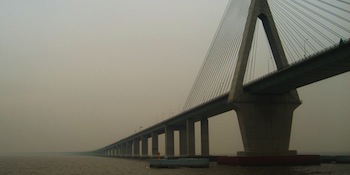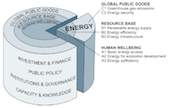In a new article in Sustainability, SEI Research Director Måns Nilsson and his co-authors suggest a framework for drafting the Sustainable Development Goals (SDGs), which will guide global development after 2015.

With the deadline for achieving the Millennium Development Goals (MDGs) about to expire, the international community is debating what comes next. At the June 2012 Conference on Sustainable Development (Rio+20), UN member states agreed to start working on a set of Sustainable Development Goals to build on the MDGs and converge with the post-2015 development agenda. But the hard work of drafting the SDGs has barely begun. SEI Research Director Måns Nilsson talks about the latest developments in the SDG process, the proposed SDG framework, and the Independent Research Forum (IRF), a new partnership that will support the SDG drafting.
Q: How far has the process of drafting the Sustainable Development Goals come?
MN: Well, to start with we have a set of principles and guidelines from The Future We Want, which was the outcome document from the Rio+20 Conference. We also have some wish lists from UN member states, particularly from a questionnaire survey last year. Numerous UN bodies, policy analysts, advocacy organizations, and research groups have made suggestions on approaches to the post-2015 development agenda and on what should be in the SDGs. But so far there’s been very little attempt to put all this into a coherent framework. We don’t yet have a real sense of what the SDGs will look like. That will be the job of the Open Working Group on the SDGs, which was formally established by the UN General Assembly in January this year.
Q: What makes the task of defining SDGs different to that of defining the MDGs?
MN: The world has changed, geopolitically and economically, since the MDGs were adopted in 2000. Some of this has been the very positive, and inspired by, if not actually a result of, the MDGs. But a host of environmental, social and, particularly, resource issues have become much higher priorities. Also, it’s now widely recognized that actions to reduce poverty in the long term need to be supported by actions to protect global public goods, including environmental, and to manage resources fairly and sustainably. This perhaps makes the SDGs more three-dimensional than the MDGs were. Finally, of course, the MDGs were the first of their kind: the first globally agreed development goals. So as well as the progress made in fulfilling the MDGs, we can build on lessons that have been learned about the strengths and weaknesses of the MDG approach.
Q: In your new paper in Sustainability you try to move the debate forward by suggesting a common framework for the SDGs. What are the basic elements of that framework?
MN: The framework is for sets of “nested” goals in a particular thematic area. Human wellbeing is at the core of the sustainable development agenda and, consequently, at the core of our framework. Thus, the first “tier” of goals in each area relates to promoting human wellbeing. Supporting these we have goals on developing the resource base and, in the third tier, goals on managing global public goods. This approach was inspired by the early deliberations of the High-level Panel on the Post-2015 Development Agenda.
In the paper we illustrate how the framework could be translated into actual goals using the thematic area of energy as an example. In that case, the core human wellbeing goals are around basic energy access, energy for economic development and energy sufficiency. Goals in the second tier, the resource base, relate to renewable energy supply, energy efficiency and energy infrastructure. In the third tier the goals are around greenhouse gas emissions and energy security. We also propose sets of “enabling goals” in each theme, relating to how the goals in the three tiers can be achieved. These fall into four groups: capacity and knowledge, institutions and governance, public policy, and investment and finance.

Q: People might argue that human wellbeing was at the heart of the MDGs, too. What’s different in your framework?
MN: The MDGs certainly tried to improve human wellbeing, especially lifting people out of poverty and lowering mortality. But because of the way they were framed, most of the change to achieve the MDGs had to be in developing countries. Our framework – and this only reflects the broad consensus in the sustainable development debate – recognizes that universal human wellbeing depends on the actions of all countries. We are now much more aware that the consumption patterns of one country affect the availability of resources for another. At the same time, the wealthier and more industrialized countries have a proportionally bigger impact on global public goods.
For this reason another important aspect of our framework is the differentiation of targets – or, more accurately – of priorities. Thus, in our energy example, we suggest that the emphasis in the lowest-income countries should be on access to energy services, while in the highest-income countries it should be on reducing per capita energy consumption. Between these we have managing demand with improved efficiency, and expanding the supply of renewable energy. Every country needs to look at its most pressing needs and where action could have the greatest impact. In some cases there might have to be trade-offs between achievement of the different goals.
Q: SEI is a member of the Independent Research Forum. What is the IRF and how will it contribute to the SDG process?
MN: The IRF is a collaborative effort by 12 environmental research organizations, including SEI, to offer credible expert advice to various bodies on how to achieve sustainable development. In the first instance we’ll be supporting the Open Working Group, and thus feeding into the SDG drafting process. The IRF website, www.IRF2015.org, has more information, along with a blog and links to our publications.
The article “Towards an integrated framework for SDGs: ultimate and enabling goals for the case of energy” by Måns Nilsson, Paul Lucas and Tetsuro Yoshida appears in the October 2013 issue of the open-access journal Sustainability.
Learn more about the SDGs at sustainabledevelopment.un.org.
Design and development by Soapbox.
